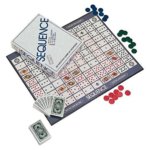Sequence at a Glance
| Game Type Abstract, Card Game, Pattern Building, Team Based | Play Time 30 - 45 mins + | Skill/Complexity (2 - 5) Light |
| Age 7+ | Publisher(s) Jax LTD, and others | Published 1982 |
| Categories Abstract Game | Players 2 - 12 (best 3 - 4) | Rules Manual Rules PDF |
| Our Rating 8/10 | Cost Approx $23.99 |
About – Description
The Sequence board game was designed by Doug Reuter and was first published in 1982. It is a board game that is suitable for players of a younger age, ranging from 7 years and upwards.
Sequence is suitable for anything from 2-12 players although it is played ideally with 3-4 players. As the game is suitable for young players, it is ideal for the family to enjoy.

Who’s it best suited for?
A challenging, yet fun and exciting board game that is perfect for families and children. The Sequence board game offers enough of a challenge for adults yet children find it easy enough to play.
It could be considered an educational game in some respects as it does require a strategy to win. Children will need to think through solutions and problem solve at the same time.
Skill – Complexity
Sequence is not a complex game but it does require some element of thinking and planning. Players have to think about the placement of their cards. It can help to develop STEM skills and so, there is some element of skill required.
It is not considered to be a difficult game due to the age. However, adults will find it interesting and children will love the challenge.
Set Up – Playing Rules & Instructions
The Sequence Board game is simple to set up and consists of 1 board, 2 decks of Sequence playing cards and 135 playing chips.

Playing the game involves players selecting a card from their hand. They then have to place the card face up on what is known as a discard pile. One of the chips is then placed in a corresponding space on the board. The challenge then lies on where they place their chip as every card is pictured twice, requiring an element of planning.
Extra excitement is added to the game as Jacks that have two eyes are known as wild cards. These then enable players to place their chips on any space on the board. If players have a one-eyed jack, they can then remove an opponent’s chip. Finally, to win the game, players must get a five-card sequence.
Versions – Editions
A number of versions of the game have been released since the original in 1982. A Jax deluxe edition was released in 1982, with an additional release coming in 1992. A 25th-anniversary version was then released in 1997.

It was then released in many countries such as Spain, France, Germany and Holland.
Fans of the game could also benefit from a travel edition which was released in 2004.
There are numerous other versions including Sequence based on numbers, cats or dogs, the Bible and a few others.
So we can safely assume that Jax the company believes in the phrase ‘variety is the spice of Sequence games’.
Likes & Dislikes
- Simplicity – anyone can play.
- Engages children easily.
- Fast game play.
- Good time filler game.
- Some may not like the high luck element.
Players like the light-hearted nature of this game due to the way it is suited to children and families. The fact that it is a simple game to learn and teach makes it appealing to a wider audience.
However, it seems as though some feel as though the game rides on luck more than judgement. Despite this, it seems as though the general feeling is that it is a game filled with fun and excitement.
Final Thoughts
The board game is a strategy based game that has a simple design and structure. It is perfect for families and for helping children to become involved with board games.
The quick playing time does make it a great choice for those times when a board game is required to lighten the atmosphere and mood.




